13th Century Grenades
The beginning of explosive ordinance was the advent of black powder, followed by Chinese firecrackers, Roman Candles and Greek Fire Bombs. England's Roger Bacon in the middle of the 1200's and Germany's Berthold Schwarts a hundred years later left written records of experiments with explosives (sulfur, carbon, and potassium nitrate). The early 13th Century Chinese may have expanded the use of fireworks to bombs and grenades. But, the first documented proof of the use of grenades to protect or defend against another militant force is in the 14th Century, when the hand cannon, stationary cannon and field cannon first came into use. By the time the Spanish were destroying the native American population in the "New World", the soldiers had grenades to use.
American Revolution Grenades
 The British restricted manufacturing and accumulation of black powder in their colonies, which the American Revolutionary Forces found out the hard way. The small black powder factories that sprang up, produced a poor variety and the Continental Congress worked to get better black powder from Germany. Besides developing a poison rifle ball, Ben Franklin designed a grenade made from sheet lead in the form of a number of small hexagons folded to make a softball size container. The grenade container was filled with black powder, broken glass and fragments of rusty old nails. The hole in the grenade was then sealed with a wick sticking out of wax. Too heavy to throw, the Franklin grenade would be rolled down an incline. No one knows if this first American grenade was ever used. The British, on the other hand, did have a small grenade that used a1/2 pound of black powder which was used during the Revolutionary War. The British restricted manufacturing and accumulation of black powder in their colonies, which the American Revolutionary Forces found out the hard way. The small black powder factories that sprang up, produced a poor variety and the Continental Congress worked to get better black powder from Germany. Besides developing a poison rifle ball, Ben Franklin designed a grenade made from sheet lead in the form of a number of small hexagons folded to make a softball size container. The grenade container was filled with black powder, broken glass and fragments of rusty old nails. The hole in the grenade was then sealed with a wick sticking out of wax. Too heavy to throw, the Franklin grenade would be rolled down an incline. No one knows if this first American grenade was ever used. The British, on the other hand, did have a small grenade that used a1/2 pound of black powder which was used during the Revolutionary War.
Civil War Grenades
 During the Civil War, the impetus for creating new ways to wage war included the "Universal Model" cylindrical grenade manufactured in Pittsburgh, Pennsylvania for the Union Army. One grenade version had simple black powder During the Civil War, the impetus for creating new ways to wage war included the "Universal Model" cylindrical grenade manufactured in Pittsburgh, Pennsylvania for the Union Army. One grenade version had simple black powder  as filling, while a more advanced grenade added metal fragments and a strychnine-like compound to the mix. A ceramic sphere packed with black powder with a cork in the hole required a fuse to detonate the grenade. The fuse had to be lit before the hand grenade was thrown. Ketchum made an 1861 patent of a hand grenade with a percussion cap activated by a "plunger" inserted just before the grenade was thrown. A year later Hanes developed the "Excelsior" grenade - a cast-iron shell with 14 nipples, each requiring attachment of a as filling, while a more advanced grenade added metal fragments and a strychnine-like compound to the mix. A ceramic sphere packed with black powder with a cork in the hole required a fuse to detonate the grenade. The fuse had to be lit before the hand grenade was thrown. Ketchum made an 1861 patent of a hand grenade with a percussion cap activated by a "plunger" inserted just before the grenade was thrown. A year later Hanes developed the "Excelsior" grenade - a cast-iron shell with 14 nipples, each requiring attachment of a 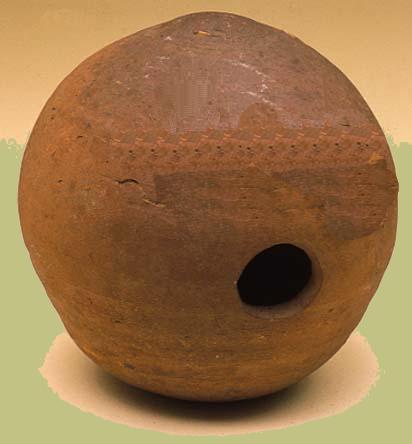 percussion cap before throwing the grenade. It would only take one cap to trigger the explosion, and soldiers trying to use Hanes's grenade found out the hard way that it was too easy to accidentally set off one of the percussions caps. This resulted in the Excelsior grenades never being used in battle. percussion cap before throwing the grenade. It would only take one cap to trigger the explosion, and soldiers trying to use Hanes's grenade found out the hard way that it was too easy to accidentally set off one of the percussions caps. This resulted in the Excelsior grenades never being used in battle.
Louisiana Confederates made their own grenades by sticking short fuses into 6 and 12 pound cannon shells. These hand grenades were lit before rolling them into Union ranks. The Federal troops learned the trick and used their own rolling hand grenades against the Confederate lines at Knoxville and against General Longstreet's troops at Chattanooga. What the Civil War demonstrated was the practical need for hand thrown grenades (versus a grenade that would only roll).
19th Century Grenades
In the last of the 19th Century, the Germans were more likely to use hand grenades than any other nation. Both the French and Germans used iron ball grenades similar to the size of the popular 6 pound cannon ball. This basic "state of the art" grenade used timed burn delay fuses, activating a charge of primarily black powder to rupture the grenade shell made of cast iron.
World War I Grenades
The Great World War (1914-1918) saw French grenades using a smooth iron ball with a friction fuse in a wooden plug. A tether allowed the solder to be relatively clear when pulling the primer . The French also issued the "racquet grenade" which was attached to a wooden paddle. By the end of World War I, the Germans reverted to the use of concrete hand grenades due to a critical materials shortage. The British were inventive and created both simple and complex grenades. None of these early WWI grenades were effective in the trench warfare that evolved.
When the battle lines became fixed with armies in a stalemate within yards of each other, the WWI grenade became the weapon of choice. Innovations by the dozens came from both sides in the quest for the perfect grenade. Each nation attempted to develop reliable grenade fuses and fragmentation patterns for both offensive and defensive operations. The defensive grenade was designed to project fragments up to 100 yards out, under the assumption a defending soldier would be in a protected location. The offensive grenades were limited to a 8-10 yard fragmentation area beyond the explosion, to protect the grenadier and other friendly troops.
 The Europeans developed weather proofing, timed delayed fuses, and high explosive ordinance for their grenades, before the US entered the war. The American grenade had a complex impact fuse system that needed to land soundly on the primer. To ensure correct flight and landing, the grenade had a kite-like rope tail which streamed behind the grenade when it was thrown and enhanced the likelihood it would go off during landing. But in the muddy trenches of Europe, this grenade would fail. The Europeans developed weather proofing, timed delayed fuses, and high explosive ordinance for their grenades, before the US entered the war. The American grenade had a complex impact fuse system that needed to land soundly on the primer. To ensure correct flight and landing, the grenade had a kite-like rope tail which streamed behind the grenade when it was thrown and enhanced the likelihood it would go off during landing. But in the muddy trenches of Europe, this grenade would fail.
American Grenades
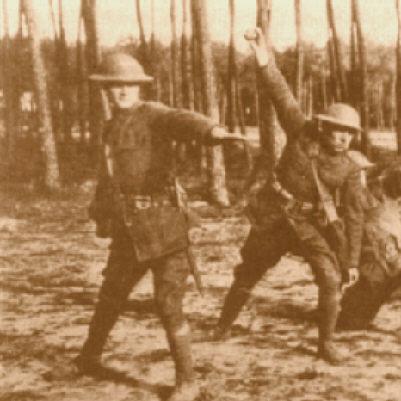 In 1917 the US Army Trench Warfare Section designed a new grenade resulting in an initial contract for 5000 grenades. This number was quickly expanded to 68,000,000 grenades manufactured by a number of companies. Production of the American grenade was in full production within 120 days. All of this grenade manufacturing came to an immediate halt when the battlefield reports arrived. To protect the grenadier, the grenade had a complicated 5 step process to become armed. Numerous reports came back about grenades being thrown without being armed, only to be returned by the enemy who had discovered how to arm the American grenade. A million grenades were tossed to the salvage bin and the American Expeditionary Force began serious warring with no grenades in July 1918. In 1917 the US Army Trench Warfare Section designed a new grenade resulting in an initial contract for 5000 grenades. This number was quickly expanded to 68,000,000 grenades manufactured by a number of companies. Production of the American grenade was in full production within 120 days. All of this grenade manufacturing came to an immediate halt when the battlefield reports arrived. To protect the grenadier, the grenade had a complicated 5 step process to become armed. Numerous reports came back about grenades being thrown without being armed, only to be returned by the enemy who had discovered how to arm the American grenade. A million grenades were tossed to the salvage bin and the American Expeditionary Force began serious warring with no grenades in July 1918.
 The Americans had to turn to their allies for grenade support and particularly the French. The French F1 grenade had a hollow cast iron body with a fragmentation enhancing pattern that gave a "pineapple" look to the grenade. With the grenade's weather proof strike primer, the soldier removed a safety cover and hit the cap to blow it off the grenade initiating a timed burn fuse. While there were numerous versions of grenade fuses, by 1917 the Billant grenade fuse system was in favor. This automatic grenade fuse system used a cast metal fuse screwed into the grenade's casing and secured with a safety pin and lever. The solder would pull the grenade pin causing the lever to release a plunger causing two hammers to fall and explode the primer and grenade. A 5 second time delay burn began within the fuse which would then set off the detonator and explosion that ruptured the grenade casing into fragments. The Americans had to turn to their allies for grenade support and particularly the French. The French F1 grenade had a hollow cast iron body with a fragmentation enhancing pattern that gave a "pineapple" look to the grenade. With the grenade's weather proof strike primer, the soldier removed a safety cover and hit the cap to blow it off the grenade initiating a timed burn fuse. While there were numerous versions of grenade fuses, by 1917 the Billant grenade fuse system was in favor. This automatic grenade fuse system used a cast metal fuse screwed into the grenade's casing and secured with a safety pin and lever. The solder would pull the grenade pin causing the lever to release a plunger causing two hammers to fall and explode the primer and grenade. A 5 second time delay burn began within the fuse which would then set off the detonator and explosion that ruptured the grenade casing into fragments.
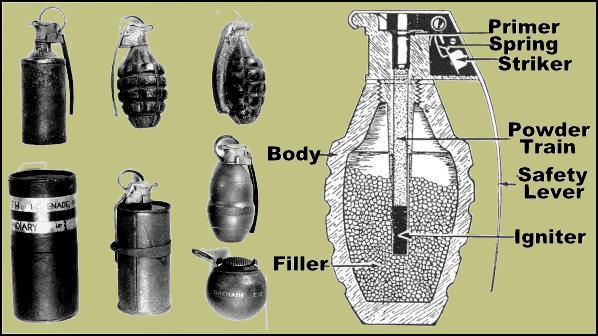 The Billant grenade fuse principals were incorporated into a new system for the redesigned US grenade. The new grenade used a safety lever secured by a safety pin with a ring attached. The Billant plunger was later replaced with a spring loaded hammer that immediately contacted the primer causing the time delay burn within the grenade. The new fuse system was used in the old US grenade castings for training purposes. A newly developed US grenade body patterned after the F1 grenade but with fewer fragmentation checking on the casing reduced the grenade weight. This basic hand grenade was used throughout WWII, Korea, and Viet Nam. The Billant grenade fuse principals were incorporated into a new system for the redesigned US grenade. The new grenade used a safety lever secured by a safety pin with a ring attached. The Billant plunger was later replaced with a spring loaded hammer that immediately contacted the primer causing the time delay burn within the grenade. The new fuse system was used in the old US grenade castings for training purposes. A newly developed US grenade body patterned after the F1 grenade but with fewer fragmentation checking on the casing reduced the grenade weight. This basic hand grenade was used throughout WWII, Korea, and Viet Nam.
Rifle Grenade Launchers - World War I
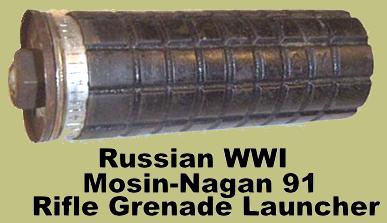 Even in WWI, there were developments to project a grenade farther than a human could possible throw one. In Russia, the WWI Mosin-Nagan 91 rifle grenade launcher was mounted on the bayonet as a grenade launcher cup. A 42mm grenade delay fuse was located on the bottom of the grenade. Blank ammo fired through the rifle launched the grenade. Even in WWI, there were developments to project a grenade farther than a human could possible throw one. In Russia, the WWI Mosin-Nagan 91 rifle grenade launcher was mounted on the bayonet as a grenade launcher cup. A 42mm grenade delay fuse was located on the bottom of the grenade. Blank ammo fired through the rifle launched the grenade.
Russian Red Army Grenade Launcher
The Russian Red Army was one of the pioneers of the rifle grenade, including the Diakanov Rifle Grenade Launcher. This drawing from a 1932 book shows the Russian rifle model 1891-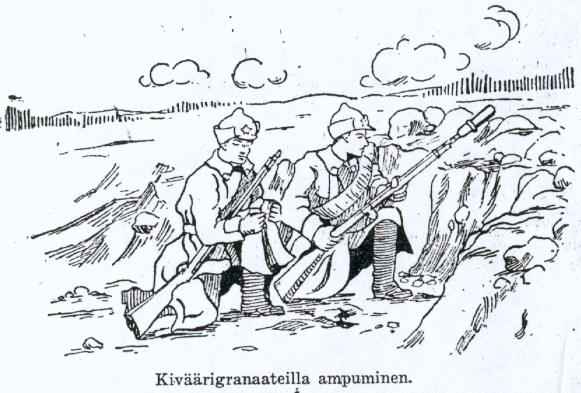 30 with the Diakanov rifle grenade attachment. It is unknown whether the Red Army soldier quoted below refer to the Diakanov or some other rifle grenade launcher: 30 with the Diakanov rifle grenade attachment. It is unknown whether the Red Army soldier quoted below refer to the Diakanov or some other rifle grenade launcher:
We received rifles and grenades which could be fastened onto the rifle barrels. Well we tried them but they proved totally worthless. When you pressed the trigger the grenade flew only about five meters and failed to explode. We then turned all that junk in. Vitjuk I. M., Red Army soldier
Before commencing shooting you were to place the rifle and the grenade on its barrel on a firm surface on the bipod and aim at the enemy (we could have figured that part out by ourselves) and then shoot with a regular cartridge. It was then that I started regretting having sinned and now being forced to haul the launcher around as extra weight. I threw the contraption away because at no point in the war were we issued any grenades for it.
Bobkov A. A., Red Army soldier, 95th Infantry Division
The Red Army strived to obtain a firepower superiority over their prospective 1930's opponents and pushed development of the rifle grenade launcher. Unlike other rifle grenade launcher systems that required the use of a special bullet in the rifle to propel the grenade, the Djakonov used a standard cartridge with the VDG1930 grenade. The VDG1930 had a hole through the middle, allowing the bullet and accompanying gases to pass which launched the grenade. The 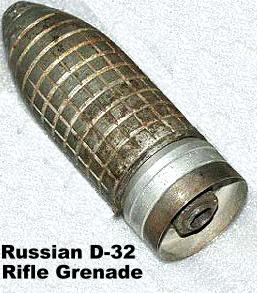 Djakonov Grenade Launcher created a spin to the grenade providing some flight stability and was supposed to obtain an 800 meter range. With no safety device, the VDG1930 grenade did not detonate on impact. Instead the grenade had a fragmentation jacket and a fuse which would detonate the grenade after a flight of 140-800 meters. There were supposedly several different explosive loads for the grenade. Djakonov Grenade Launcher created a spin to the grenade providing some flight stability and was supposed to obtain an 800 meter range. With no safety device, the VDG1930 grenade did not detonate on impact. Instead the grenade had a fragmentation jacket and a fuse which would detonate the grenade after a flight of 140-800 meters. There were supposedly several different explosive loads for the grenade.
The Russian Mosin-Nagan rifle grenade launcher fired a D-32 rifle grenade. The grenade had a bullet passage lined with a steel tube that can be seen in the photo to the left. This grenade's bullet passage had a similar diameter to the Russian rifle bullet.
Early US Rifle Grenade Launcher
The US M7 and M7A1 Grenade Launchers were extensions to the .30 M1 Garand Rifle (standard issue 1936-1957). Using a hinged clamp, the grenade launcher was attached to the bayonet lug and gas cylinder valve screw. By firing a special rifle cartridge, the gas produced a thrust that sent the grenade down field. Later improvements 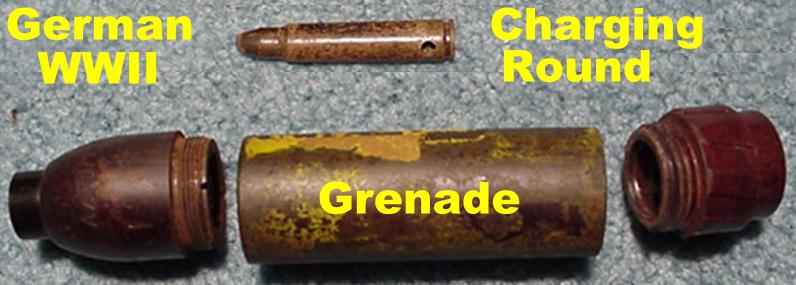 added a propelling charge to the grenade that was ignited by the flame from the fired rifle cartridge to obtain greater range. This same ignition operation could ignite a time delay fuse for signal and illumination rifle grenades. added a propelling charge to the grenade that was ignited by the flame from the fired rifle cartridge to obtain greater range. This same ignition operation could ignite a time delay fuse for signal and illumination rifle grenades.
The M1 Carbine used the M8 grenade launcher clamped to the end of the barrel with a wing nut. Some ordinance was dedicated rifle grenade, such as the M9/M9A1 HEAT anti-tank grenade. The M9 grenade contained a shaped charge that could penetrate 3-4 inches of armor at a maximum effective range of 250 yards.
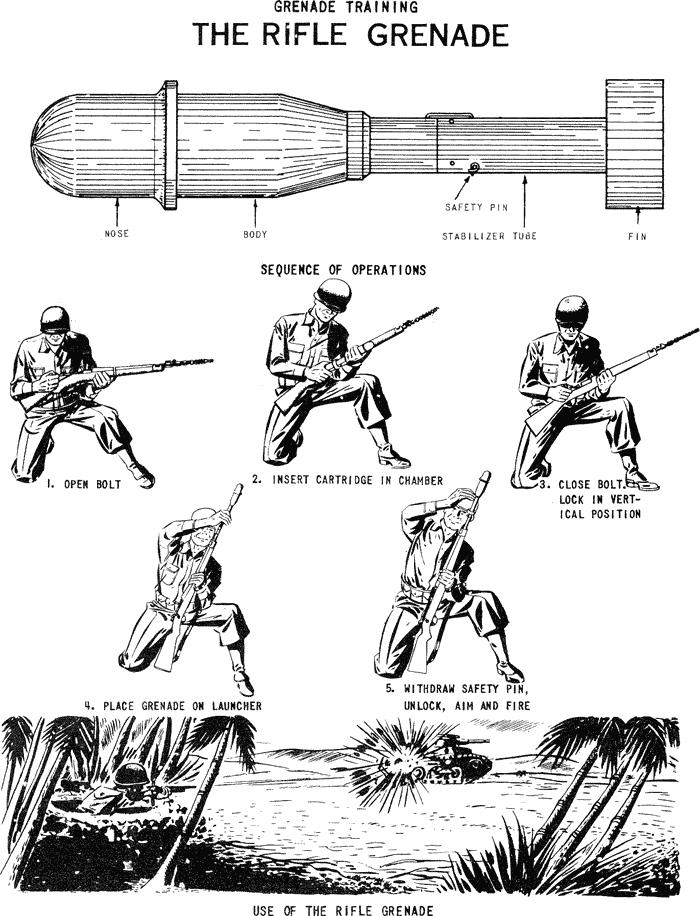
The above drawing depicting firing of the US rifle grenade by line-of-sight was most likely done by someone who had never fired a rifle grenade launcher. The heavy recoil from firing the grenade actually required the rifle to be secured by placing the stock on the ground.
Rifle Launcher Grenade 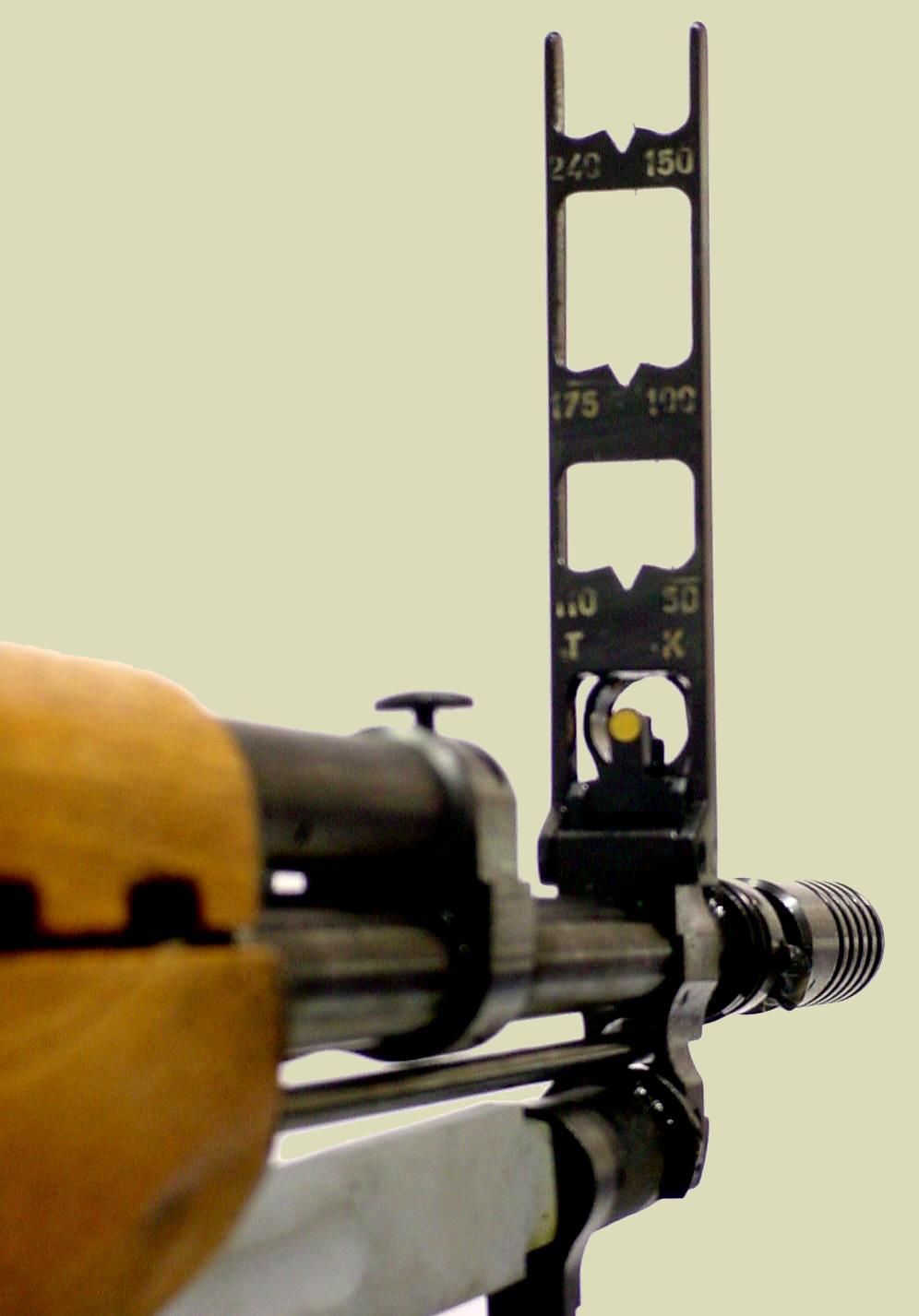
 Yugoslavians produced the SKS M59/66 rifle in 1966, which was "state of the art" at that time for the rifle grenade launcher. The rifle grenade launcher fit on the barrel and a gas cutoff valve was on the gas block. The grenade launcher folding front sight was marked by six different ranges. Yugoslavians produced the SKS M59/66 rifle in 1966, which was "state of the art" at that time for the rifle grenade launcher. The rifle grenade launcher fit on the barrel and a gas cutoff valve was on the gas block. The grenade launcher folding front sight was marked by six different ranges.
M79 US Grenade Launcher Viet Nam Era
 Perhaps the most dramatic evolution to the grenade came in 1961 when the the first M79 Grenade Launcher was delivered to the US Army. This weapon was solely dedicated to shooting the 40mm grenade. The M79 was designed to accurately fill the gap between the maximum 50 meter range of a hand thrown grenade and the 300 meters of mortar fire. The rifled 40mm barrel of the M79 caused a spinning which helped stabilize the grenade's flight and also used centrifugal force to arm the grenade after a flight of about 15 meters. The M79 40mm Grenade Launcher was very accurate up to 200 meters. Perhaps the most dramatic evolution to the grenade came in 1961 when the the first M79 Grenade Launcher was delivered to the US Army. This weapon was solely dedicated to shooting the 40mm grenade. The M79 was designed to accurately fill the gap between the maximum 50 meter range of a hand thrown grenade and the 300 meters of mortar fire. The rifled 40mm barrel of the M79 caused a spinning which helped stabilize the grenade's flight and also used centrifugal force to arm the grenade after a flight of about 15 meters. The M79 40mm Grenade Launcher was very accurate up to 200 meters.
The M79 Grenade Launcher looked like a shotgun with a huge barrel. The M79 is a single shot, shoulder fired grenade launcher with a break-barrel loader that fired a spherical 40mm grenade. The steel M-406 40mm HE grenade would explode upon impact and could send over 300 fragments out to a lethal radius of up to 5 meters. To fully utilize this new weapon, the US developed new grenades. One M79 40mm grenade contained approximately 45 small darts in a casing made of plastic. This version was replaced by the M-576 grenade filled with 27 rounds of 00 buckshot. The M-576 grenade was carried down the M79 barrel on top of a 40mm plastic sabot (like a sled). Upon leaving the grenade launcher barrel, the buckshot traveled forward un-aided. The M79 grenade launcher also fired non-lethal grenades with smoke, CS gas and flares.
M203 US 40mm Grenade Launcher
 While an interesting addition to the US arsenal in Viet Nam, the M79 Grenade Launcher had a limited usage due to its weight and the loss of small arms fire capability. The M79 was carried as an extra weapon that was both heavy and cumbersome. To counter this, the M203 40mm grenade launcher was created. The M203 was attached to the M16 Rifle. While an interesting addition to the US arsenal in Viet Nam, the M79 Grenade Launcher had a limited usage due to its weight and the loss of small arms fire capability. The M79 was carried as an extra weapon that was both heavy and cumbersome. To counter this, the M203 40mm grenade launcher was created. The M203 was attached to the M16 Rifle.
M203PI Enhanced Grenade Launcher Modular (EGLM) System
 The next step in the evolution of the 40mm grenade launcher came with the advent of the M203PI 40mm Enhanced Grenade Launcher Modular (EGLM) System. The shorter barrel and the ability to attach the grenade launcher to many different types of rifles, makes the M203PI EGLM a more flexible addition to any arsenal. The next step in the evolution of the 40mm grenade launcher came with the advent of the M203PI 40mm Enhanced Grenade Launcher Modular (EGLM) System. The shorter barrel and the ability to attach the grenade launcher to many different types of rifles, makes the M203PI EGLM a more flexible addition to any arsenal.
M203PI EGLM Tactical Mount
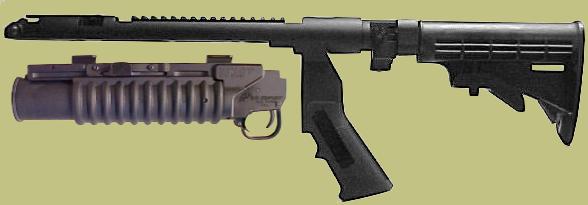 The EGLM concept was taken further in 1996 when RM Equipment, Inc. introduced the M203PI EGLM Tactical Mount. This "stand-alone" mounting system takes the positive aspects of the M79 and eliminates the bulky problems. RM's Tactical Mount gives the grenadier a compact, lightweight M203 grenade launcher with a telescoping and folding stock assembly providing complete tactical flexibility. The EGLM concept was taken further in 1996 when RM Equipment, Inc. introduced the M203PI EGLM Tactical Mount. This "stand-alone" mounting system takes the positive aspects of the M79 and eliminates the bulky problems. RM's Tactical Mount gives the grenadier a compact, lightweight M203 grenade launcher with a telescoping and folding stock assembly providing complete tactical flexibility.
|
![]() RM Equipment, Inc.
RM Equipment, Inc. To see more on the M203PI EGLM: m203pi.com
To see more on the M203PI EGLM: m203pi.com Got a 40mm grenade launcher and need a grip: M203grip.com
Got a 40mm grenade launcher and need a grip: M203grip.com  To see more from RM Equipment: 40mm.com
To see more from RM Equipment: 40mm.com  During the Civil War, the impetus for creating new ways to wage war included the
During the Civil War, the impetus for creating new ways to wage war included the  as filling, while a more advanced grenade added metal fragments and a strychnine-like compound to the mix. A ceramic sphere packed with black powder with a cork in the hole required a fuse to detonate the grenade. The fuse had to be lit before the hand grenade was thrown.
as filling, while a more advanced grenade added metal fragments and a strychnine-like compound to the mix. A ceramic sphere packed with black powder with a cork in the hole required a fuse to detonate the grenade. The fuse had to be lit before the hand grenade was thrown.  percussion cap before throwing the grenade. It would only take one cap to trigger the explosion, and soldiers trying to use Hanes's grenade found out the hard way that it was too easy to accidentally set off one of the percussions caps. This resulted in the Excelsior grenades never being used in battle.
percussion cap before throwing the grenade. It would only take one cap to trigger the explosion, and soldiers trying to use Hanes's grenade found out the hard way that it was too easy to accidentally set off one of the percussions caps. This resulted in the Excelsior grenades never being used in battle. The Europeans developed weather proofing, timed delayed fuses, and high explosive ordinance for their grenades, before the US entered the war. The
The Europeans developed weather proofing, timed delayed fuses, and high explosive ordinance for their grenades, before the US entered the war. The  In 1917 the US Army Trench Warfare Section designed a
In 1917 the US Army Trench Warfare Section designed a  The Americans had to turn to their allies for
The Americans had to turn to their allies for  The
The  Even in WWI, there were developments to project a grenade farther than a human could possible throw one.
Even in WWI, there were developments to project a grenade farther than a human could possible throw one.  30 with the Diakanov
30 with the Diakanov  Djakonov Grenade Launcher created a spin to the grenade providing some flight stability and was supposed to obtain an 800 meter range. With no safety device, the VDG1930 grenade did not detonate on impact. Instead the grenade had a fragmentation jacket and a fuse which would detonate the grenade after a flight of 140-800 meters. There were supposedly several different explosive loads for the grenade.
Djakonov Grenade Launcher created a spin to the grenade providing some flight stability and was supposed to obtain an 800 meter range. With no safety device, the VDG1930 grenade did not detonate on impact. Instead the grenade had a fragmentation jacket and a fuse which would detonate the grenade after a flight of 140-800 meters. There were supposedly several different explosive loads for the grenade.
